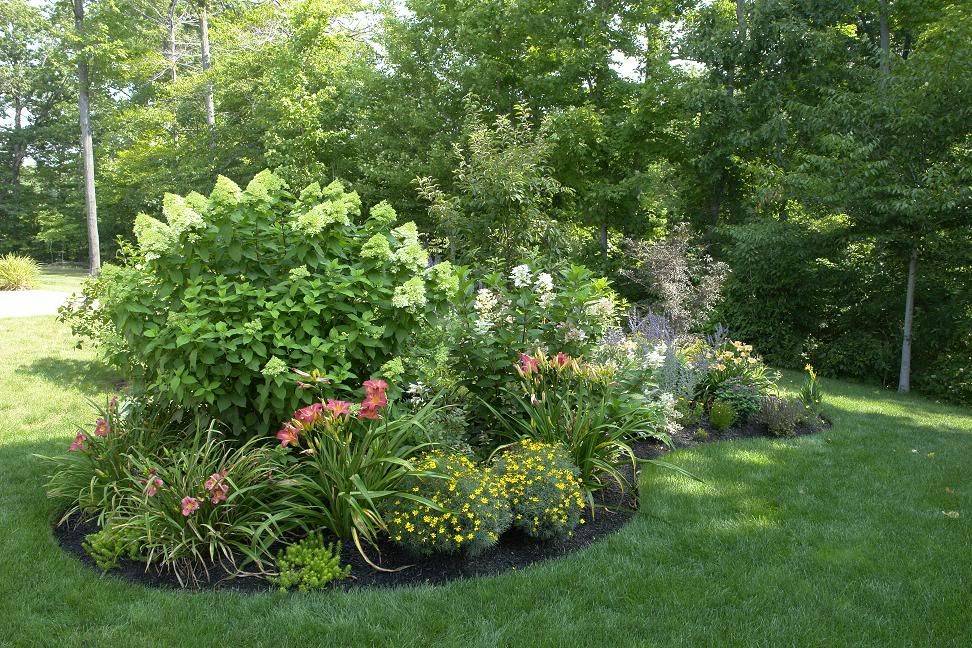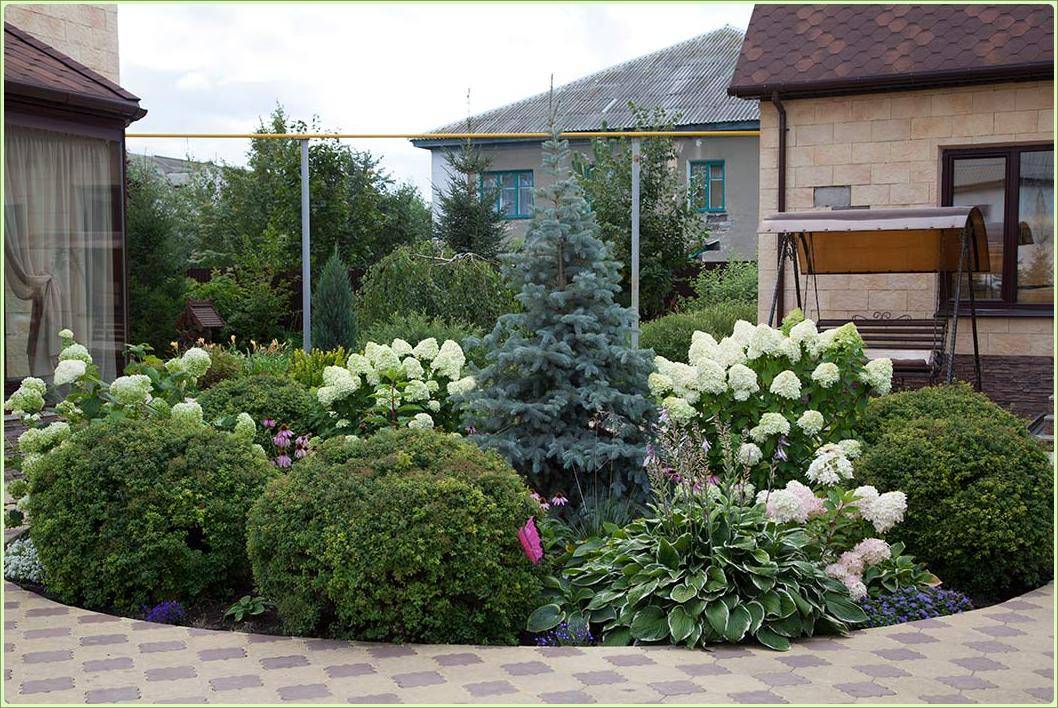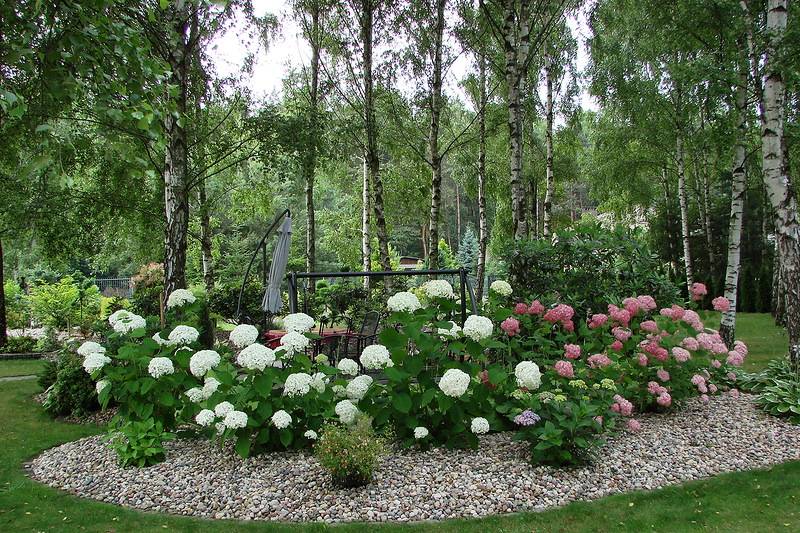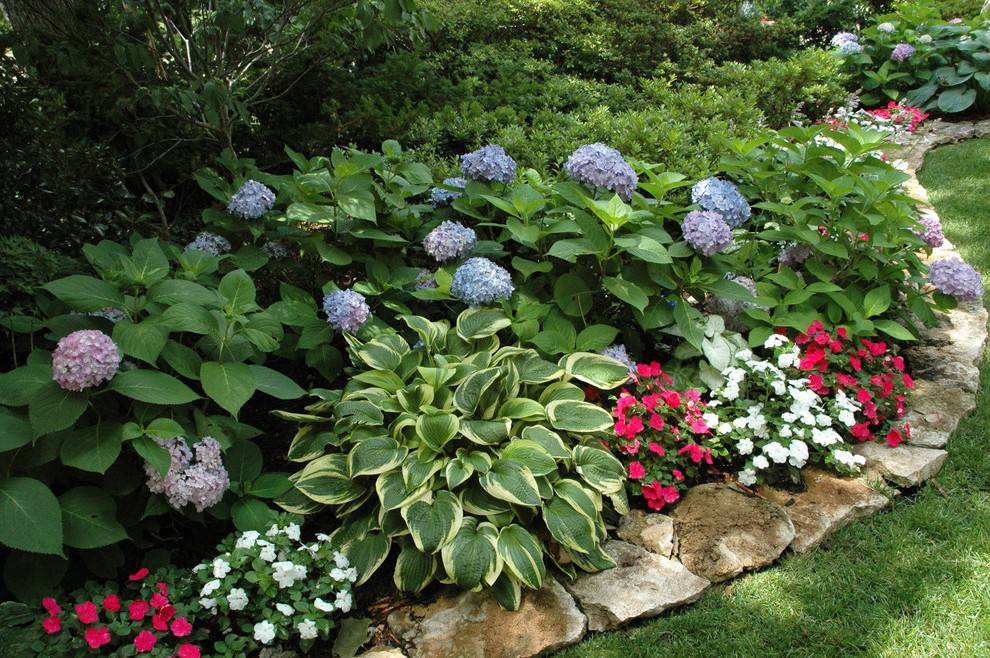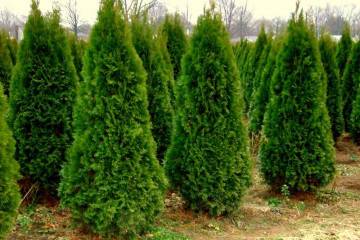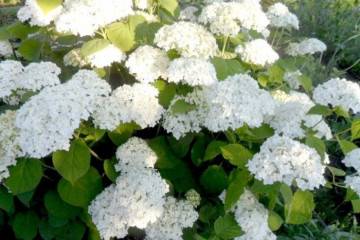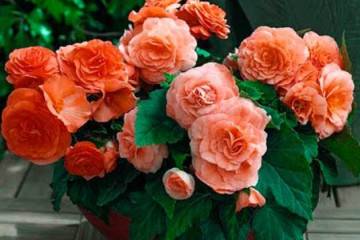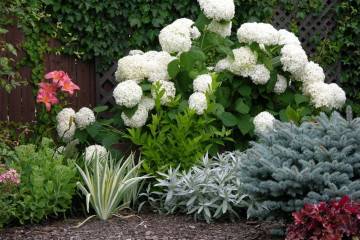Flowerbed with hydrangea - planting scheme of bushes
Content:
There are 40 types of hydrangeas growing in Russia. It is a tree-like perennial shrub, an ornamental flower. Gardeners often grow panicle hydrangea. The garden, which has a flower bed with hydrangea, looks rich.
Flowerbed with hydrangea
The beauty of hydrangea (another name for hydrangea) in its inflorescences. They are in the form of a brush, a wide pyramid or a ball. Flowers are small fertile (fertile) and large sterile (sterile).
Leaves are long, round bush, reaches from 1 to 3 m in height. This determines the decorative properties of the plant and the popularity of its application in flower beds.
Planting scheme for hydrangea paniculata
If a flower garden is a limited space with many flowers, then a flower bed is an element of a flower garden.
Plants in a flower bed are not planted randomly. They form a kind of pattern, ornament, that is, they are planted according to a scheme thought out in advance.
Drawings on a flower bed are often of a geometric shape: square, circle, rhombus. They require enough space to view the beauty from the outside. Therefore, not every flower garden can boast of a well-organized flower bed.
With all the variety, flower beds are divided into several types:
- Carpet - dwarf plants with colored foliage are planted. It looks like an oriental carpet.
- Regular - all crops bloom at the same time. This is a prerequisite.
- Irregular - plants bloom in turn, one flowering wave replaces another.
- Monoclumba - flowers of the same type are planted.
Hydrangeas fit into the irregular flower bed pattern. They are arranged in front of the house.
Early spring blooms first: lacfiol, daisies, forget-me-nots. Bulbous plants (daffodils, tulips) are planted in autumn. The main accent of such a flower bed is hydrangea.
When bulbous and early spring flowers fade, they are replaced with summer-flowering annuals: Turkish carnation, zinnia, marigolds, verbena, begonia.
The freed bald spots are filled with autumn annuals and perennial flowers: pink and purple phlox, white and purple delphinium, burgundy celosia.
In the middle of the flower bed, the hydrangea remains unchanged, which literally enchants with its flowering.
The principle of forming a flower garden
When organizing a flower garden with hydrangea, take into account the general principles:
- A plan is created on which the location of each flower is indicated.
- They study cultures: in what soil they grow, sun- or shade-loving (do not plant nearby), resistance to wind.
- Combination with each other: color of flowers and leaves, flowering period, do they get along side by side.
- They prepare the soil for different crops, clarify what fertilizers each plant needs.
When the flower bed is supposed to be admired from one side, it is placed along the fence or curb. Hydrangea is planted in the background.
If the review is from all sides, then it is located in the center.
Flowerbed with hydrangea and hosts
Hydrangea is a versatile flower. It is appreciated for stable decorativeness, bright foliage, pastel colors. It is planted separately and in groups, mixed with evergreen and deciduous crops.
Long and colorful flowering, various forms of inflorescences, unpretentious care - all this makes the flower irreplaceable in garden design. One of the advantages important for central and northern Russia is its frost resistance.The culture has been growing in one place for many years. Around and around it, varieties and types of flowers change, so every year the garden looks different.
These include hosts. Perennial flowers, they are suitable for hydrangeas in terms of growing conditions: both love partial shade, suffer from direct rays. They are settled in shady and damp corners of the garden.
Hydrangea, surrounded by hosts, looks impressive. They accentuate her style. This group gives the garden character and personality.
Hydrangea and coniferous compositions
The flower is varied in varieties. They differ in size, bush shape, color of inflorescences.
But in garden design, the leading place belongs to panicle hydrangea. It is placed singly, used in a group planting, or in a hedge. For "lonely" species with spreading crowns are suitable. To be conspicuous, they are planted away from trees. In this case, they work on the shape of the bush, pruning they achieve the ideal proportion.
Once the hydrangea was planted only in flowering hedges. Now there is a fashionable and practical trend to plant hydrangea in a flower garden where you need to create catchy and expressive accents.
Hydrangeas can be perfectly combined with conifers. For example, thuja Smaragd is in the center of the composition. Its lower branches lie on the ground. An evergreen tree with bright needles becomes the backdrop for a blooming hydrangea. The need for sun and moisture are the same, so they get along well.
The narrow pyramidal shape contrasts beautifully with the spherical hydrangea bush. Any garden with coniferous compositions and panicle hydrangea wins in terms of simplicity and originality of the solution.
Thuja Amber Glow is a representative of conifers, which is also combined with hydrangea. It is a dwarf plant, well below the hydrangea. Has the appearance of golden balls. This thuja is planted in front of the hydrangea.
The neighborhood of thuja with its neat crown and hydrangea emphasizes the well-groomed garden. It is good when birches, barberries, maples, bird cherry, lilacs are in the background. It will be unsuccessful to plant a "purple sun", as the hydrangea is called in Japan, against the background of a pine tree with long needles.
Hydrangea in landscape design
Russian gardeners and gardeners are interested not only in growing vegetables. Mass interest in flowers has become a sign of recent times. Amateur gardeners are actively interested in ornamental crops, the rules for the formation of flower beds, lawns.
Flower bed for beginners
The hydrangea is original in the design of Russian gardens. This is an affordable flower that lives for many years and does not require careful maintenance. A flower bed can be formed near an already growing flower, or it can be planted in the place of the planned flower bed.
They are guided by the rule of regular and irregular compositions.
- Regular assumes the presence of a pattern inside. Plants bloom at the same time, each planted along a certain line, clear boundaries between them.
- On an irregular flower bed, plants are grouped. For summer cottages, this is most optimal, because alternate flowering increases the total time of beauty and pleasure from contemplation.
There are ready-made schemes and rules for creating flower beds. It is easy to pick flowers from them that will be combined with each other, will be able to get along in the same space.
The shape of the flower bed is chosen based on the size of the garden, free area. They observe the pattern: in the center there are tall and bright flowers, then they are medium in size. The edges are framed by undersized or grass.
"Children's" flower bed
Children have an interest in growing flowers and should be encouraged.Therefore, the child is not prevented from planting plants and creating flower beds.
Seeds are chosen with the child. If you want early flowering, then buy seedlings (viola, petunias). It is planted, and the seeds are sown together with a little helper.
The child is explained the rules of care, given concepts about plant varieties, the rules for the formation of flower beds.
Colors are chosen bright, cheerful. For example, orange marigolds combined with red cosme. At the children's site, you cannot do without a decorative sunflower, an artificial wattle fence with a pumpkin. Under the "fence" stunted marigolds bloom, herbs grow.
The corner of the garden where children are in charge should be elegant. Red and white zinnias work well.
Girls are invited to create a flower garden in pink colors. To do this, use lavater, cosme. For boys, a front garden in blue and white tones is created from vydka, convolvulus and white zinnias.
Shady flower bed with daylilies and panicle hydrangea
The shady corners of the garden are favorite places to relax in the summer heat. It is this territory that is equipped with shade-loving plants. The best of them are daylilies of different varieties, as well as panicle hydrangea.
There is little trouble with planting in the shade, because shade-loving plants are unpretentious, and decorative stability is high.
In shady flower beds, the soil is monitored. It must pass water and air well. In areas with heavy soil, drainage is done.
When choosing plants, they adhere to the classic rule: growth, flowering time, leaf shape.
Panicle hydrangea is planted in the center. Nearby are Liliaceae - common redhead and Stella de Oro. A peony will have to be in place. They have a different flowering period, the duration of beauty in a flower bed increases.
A small forest violet grows under the "feet". All the empty space is filled with ground cover ivy.
A flower bed along a fence or wall
Each suburban area or village courtyard is limited by a fence. Florists do not waste this place - they plant flowers along the fence.
When choosing plants, take into account what material the fence is from, solid or picket fence, what height.
Drought-resistant crops that need a lot of light are planted on the south side. On this side, the plants are constantly watered. Thyme, iris, mallow are suitable. Hydrangeas are planted in the shade of a tree, as well as crocuses and tulips.
But hydrangea feels best on the north side. Hosta and conifers go to her company. Junipers and ferns are beautiful next to hydrangea.
Hydrangea is created for flower beds - it is always in the center of the composition. Suitable for single planting, looks good in a group of plants. It has high decorative properties and is in demand in landscape design.
